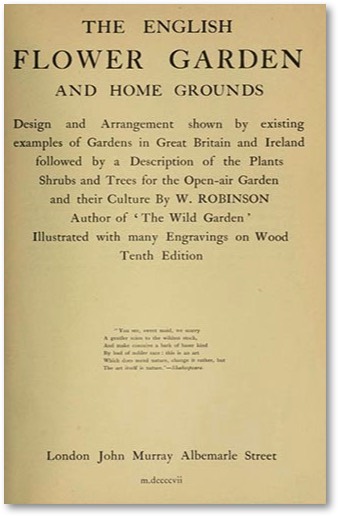
Musings » The English Flower Garden and Home Grounds


London
John Murray 1911
As readers of this column know the club has a charming library caught in a time warp. The founding mothers bought many flower and horticulture books during the early years of the club’s existence. Only a very few can be considered “valuable”. The book I shall discuss here is one of them.
William Robinson and Gertrude Jekyll brought about a revolution in English gardens and taste. No style is so hateful as that which our parents thought the best. Landscape design embodies that dictum just as thoroughly as clothing and furniture.
“Capability ” Brown tore out the parterres and formal plantings of the seventeenth century. Victorians like Andrew Downing put the fussiness back in different ways, in part because the imported flowers from China and Japan, Central and South America lent themselves to very showy layouts. The abomination of “carpet bedding” dates from that era.
At the end of the nineteenth century, artists were rebelling against the shallow and sentimental artificiality of current taste. William Morris turned back to the Mediaeval period for inspiration, deeming its very complex aesthetics to be “simple” and “natural”.
Gertrude Jekyll, a textbook example of the energetic Victorian spinster, but driven by powerful artistry, turned from painting to gardening, using the same concepts of color and design. Flowers should be planted in borders for their color, form and ability to combine in coherent groups.
William Robinson was a garden writer and designer. One of his earlier books was “The Wild Garden”. He took up the cause with Miss Jekyll. Lest anyone think that the refined manners of English society applied to gardening, read a few pages of Robinson. The gloves were really off.
The book is in two sections. The first part deals with landscape design and how it ought to take the natural beauty of the English countryside into account. He ridiculed the Crystal Palace with its “poor imitation of Italian gardening”. Robinson is very thorough. Many chapters cover all the possibilities of special gardens and varying seasons.
In the second section, he explores the botanical and horticultural aspects of the plants he suggests and the best methods to care for them. The book was so successful it went through eleven editions, from its first appearance in 1883 to the one we have, issued in 1911. The improbable combination of Jekyll and Robinson triumphed, and that is why the book remains valuable.

